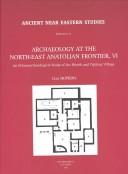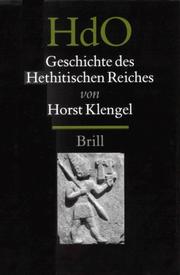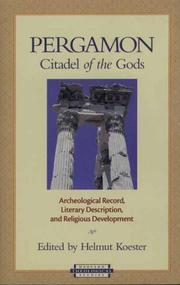| Listing 1 - 10 of 34 | << page >> |
Sort by
|
Book
ISBN: 9783515090353 3515090355 Year: 2008 Volume: 196 Publisher: Stuttgart: Steiner,
Abstract | Keywords | Export | Availability | Bookmark
 Loading...
Loading...Choose an application
- Reference Manager
- EndNote
- RefWorks (Direct export to RefWorks)
Seleucids --- Séleucides --- 939.2 --- Séleucides --- History Ancient world Western Asia Minor --- Syria --- Syrie --- History --- Histoire
Book
ISBN: 9783161525155 3161525159 9783161568619 3161568613 Year: 2021 Publisher: Tübingen : Mohr Siebeck,
Abstract | Keywords | Export | Availability | Bookmark
 Loading...
Loading...Choose an application
- Reference Manager
- EndNote
- RefWorks (Direct export to RefWorks)
Devotion to Artemis dominated the religious culture of ancient Ephesos. But she was not alone. The city of Ephesos and its environs offered a rich panoply of religious options, domestic and public. Structures, statutes, coins, inscriptions, and texts testify to the remarkable diversity of religious ideas and practices in Ephesos. Greek, Roman, Egyptian, and Jewish religious traditions found loyal adherents among residents and visitors. Gods, goddesses, heroes, and emperors were worshipped. The contributions in this volume demonstrate that ancient Ephesos was a vibrant and competitive religious environment.
939.2 --- 939.2 Geschiedenis van Westelijk Klein-Azië: Phrygia; Mysia; Troia; Pergamon; Lydia; Smyrna; Ephesus; Halikarnassos; Milete; Bithynia; Pisidia; Pamphylia --- Geschiedenis van Westelijk Klein-Azië: Phrygia; Mysia; Troia; Pergamon; Lydia; Smyrna; Ephesus; Halikarnassos; Milete; Bithynia; Pisidia; Pamphylia

ISBN: 9042911557 Year: 2003 Publisher: Louvain Paris Dudley Peeters
Abstract | Keywords | Export | Availability | Bookmark
 Loading...
Loading...Choose an application
- Reference Manager
- EndNote
- RefWorks (Direct export to RefWorks)
Bronze age --- Excavations (Archaeology) --- 939.2 --- History Ancient world Western Asia Minor --- Sos Mound (Turkey) --- Turkey --- Sos Hüyük (Turkey) --- Antiquities. --- Antiquities
Book
ISBN: 291002315X 2356132597 9782910023157 Year: 1999 Volume: 3 Publisher: Paris: De Boccard,
Abstract | Keywords | Export | Availability | Bookmark
 Loading...
Loading...Choose an application
- Reference Manager
- EndNote
- RefWorks (Direct export to RefWorks)
Le présent ouvrage a pour ambition de combler une lacune qui devient de plus en plus évidente : l'étude de l'Asie Mineure au ive siècle a.C. n'a donné lieu à aucun ouvrage de synthèse depuis W. Judeich, Kleinasiatische Studien 1892. Dans un premier ensemble de chapitres sont analysés les rouages de l'administration perse en Anatolie : le système satrapique, ses subdivisions et l'histoire de son évolution depuis sa création. Dans une deuxième partie, c'est l'histoire politique que l'on s'efforce de reconstituer malgré les zones d'ombre inévitables pour toute histoire régionale. À cet effet est mis en œuvre l'ensemble des sources disponibles : œuvres littéraires d'Hérodote à Strabon, mais aussi données archéologiques, inscriptions et monnaies, qui permettent de renouveler complètement certaines questions. La « grande » révolte des satrapes de 362 et l'anabase d'Alexandre donnent l'occasion de dresser un tableau régional visant à monter la diversité des situations qui caractérise bien l'Anatolie, carrefour de peuples et de civilisations. This study aims to fill a gap which has become more and more obvious: the study of Asia Minor in the fourth century BC has not seen a work of synthesis since W. Judeich, Kleinasiatische Studien, 1892. The first set of chapters analyzes the machinery of Persian administration in Anatolia: the satrapal system, its subdivisions, and the history of its evolution from its foundation. The second part attempts to reconstruct political history, despite the inevitable obscurities in any regional history. All available sources are put to work in this effort: literary works from Herodotos to Strabo, archaeological evidence, inscriptions, and coins, which sometimes allow a complete reexamination of certain questions. The “great” revolt of the satraps of 362 and the expedition of Alexander provide the opportunity to construct a regional picture which aspires to show the diversity that characterizes Anatolia, crossroads of peoples and…
Provincial governments --- History --- Turkey --- Politics and government --- -939.2 --- Subnational governments --- -History Ancient world Western Asia Minor --- Politics and government. --- Asie Mineure --- Histoire --- 939.2 --- History Ancient world Western Asia Minor --- Achaemenid dynasty --- Provincial governments - Turkey - History - To 1500 --- Turkey - Politics and government --- satrape --- administration perse --- Anabase --- histoire politique --- système satrapique --- archéologie --- IVe siècle av. J.-C.

ISBN: 9004102019 9789004102019 9004294066 9789004294066 Year: 1999 Volume: 34 Publisher: Leiden: Brill,
Abstract | Keywords | Export | Availability | Bookmark
 Loading...
Loading...Choose an application
- Reference Manager
- EndNote
- RefWorks (Direct export to RefWorks)
The Anatolian people of the Hittites (ca. 1700-1200 B.C.) are the subject of the underlying work. In recent decades scholars have increased our knowledge in the field enormously without bringing the new insights together in a new comprehensive handbook. This long-awaited handbook deals with the whole of the influential political history of the Hittite Empire. After an introduction on the natural conditions of Anatolia, chapters follow on the Hittite history of the early period, the old kingdom of the Hittites, the 'middle' kingdom and, extensively, the new kingdom or empire period. The book is organized chronologically, and each chapter starts with a section on the sources and secondary literature, followed by the actual text on the subsequent periods. In a separate chapter Professor Fiorella Imparati offers a survey on the political structure of the Hittite Kingdom and its foreign policy. Chronological tables, a bibliography arranged by the subsequent periods, a section on problems, and several illustrations conclude this important volume. Given the tremendous amount of material and its lucid organisation this will be one of the few reference works on the Hittites for years to come.
Hittites --- History --- Histoire --- History. --- 939.455 --- -939.2 --- Chatti --- Kheta --- Khita --- Indo-Europeans --- Geschiedenis van de Hittieten --- History Ancient world Western Asia Minor --- Hettieten. --- Politieke geschiedenis. --- Hethiter. --- 939.455 Geschiedenis van de Hittieten --- 939.2 --- History of Asia --- Antiquity --- Hittites - History.
Book

ISBN: 9789042937291 9042937297 9789042937307 Year: 2019 Publisher: Leuven Paris Bristol, CT Peeters
Abstract | Keywords | Export | Availability | Bookmark
 Loading...
Loading...Choose an application
- Reference Manager
- EndNote
- RefWorks (Direct export to RefWorks)
This book provides a detailed insight into the typology, characteristics and conceptual and iconographic elements of the solar and lunar divinities of Asia Minor. It has a special focus on native or indigenised cults. Furthermore, Anatolian divinities are studied not only in the Roman, but also during the incipient phases of these cults. The main topics include issues of polymorphism, polyonymy and the specific cultural adaptations of the Anatolian deities, the world of the gods, that of mortals and the relations between dedicators and divinities. The first part studies the origin of the name and of the divinity, an attempt to determine the area of dessemination, epithets, attributes, identifications with other gods, myths and the associated divinities, as well as symbolism and iconographical elements. The second part features the economic life of the temples, the organisation of the sacred space, the nature of the priesthood and the categories of dedicators, association patterns, age and kinship, and the alterations that occurred during this period in the perception of the divine world both in the Anatolian area and throughout the Roman empire. In the last part of the volume the reader can find useful information regarding the typology of inscriptions used by the author and the means of communication between the divine world and the terrestrial one.
Inscriptions, Ancient --- Inscriptions, Ancient. --- Moon worship --- Moon worship. --- Sun worship --- Sun worship. --- Temples --- Temples. --- To 1500. --- Asia Minor. --- Turkey --- Turkey. --- Religious life and customs --- History --- 939.2 --- 939.2 Geschiedenis van Westelijk Klein-Azië: Phrygia; Mysia; Troia; Pergamon; Lydia; Smyrna; Ephesus; Halikarnassos; Milete; Bithynia; Pisidia; Pamphylia --- Geschiedenis van Westelijk Klein-Azië: Phrygia; Mysia; Troia; Pergamon; Lydia; Smyrna; Ephesus; Halikarnassos; Milete; Bithynia; Pisidia; Pamphylia
Book
ISBN: 9783110318371 3110318490 9783110318487 3110318377 9783110318494 3110318482 Year: 2013 Volume: 64 Publisher: Berlin: de Gruyter,
Abstract | Keywords | Export | Availability | Bookmark
 Loading...
Loading...Choose an application
- Reference Manager
- EndNote
- RefWorks (Direct export to RefWorks)
Turkey --- Aegean Islands (Greece and Turkey) --- Turquie --- Egée, Iles de la mer (Grèce et Turquie) --- Religion. --- Religion --- 291.3 --- 939.2 --- Godsdienstwetenschap: cultus; liturgie --- Geschiedenis van Westelijk Klein-Azië: Phrygia; Mysia; Troia; Pergamon; Lydia; Smyrna; Ephesus; Halikarnassos; Milete; Bithynia; Pisidia; Pamphylia --- 939.2 Geschiedenis van Westelijk Klein-Azië: Phrygia; Mysia; Troia; Pergamon; Lydia; Smyrna; Ephesus; Halikarnassos; Milete; Bithynia; Pisidia; Pamphylia --- 291.3 Godsdienstwetenschap: cultus; liturgie --- Egée, Iles de la mer (Grèce et Turquie)
Book
ISBN: 9789042921085 9042921080 Year: 2008 Volume: 6 Publisher: Leuven: Peeters,
Abstract | Keywords | Export | Availability | Bookmark
 Loading...
Loading...Choose an application
- Reference Manager
- EndNote
- RefWorks (Direct export to RefWorks)
Bible NT. Revelation --- Ephesus --- 939.2 --- 27 <392 EPHESE> --- 228 --- Geschiedenis van Westelijk Klein-Azië: Phrygia; Mysia; Troia; Pergamon; Lydia; Smyrna; Ephesus; Halikarnassos; Milete; Bithynia; Pisidia; Pamphylia --- Kerkgeschiedenis--Westelijk Klein-Azië: Troje; Mysië; Frygië; Pergamon; Lydië; Smyrna; Efese; Halicarnassus; Milete; Bithynië; Pisidië; Pamfylië--EPHESE --- Apocalyps. Boek der Openbaring van Johannes. Apocalyptiek --- 939.2 Geschiedenis van Westelijk Klein-Azië: Phrygia; Mysia; Troia; Pergamon; Lydia; Smyrna; Ephesus; Halikarnassos; Milete; Bithynia; Pisidia; Pamphylia --- Church history --- Bible. --- Criticism, interpretation, etc. --- Ephesus (Extinct city) --- History. --- Church history - Primitive and early church, ca. 30-600. --- Ephesus (Extinct city) - History.

ISBN: 156338261X Year: 1998 Volume: 46 Publisher: Harrisburg, Pa. : Trinity Press International,
Abstract | Keywords | Export | Availability | Bookmark
 Loading...
Loading...Choose an application
- Reference Manager
- EndNote
- RefWorks (Direct export to RefWorks)
Excavations (Archaeology) --- Fouilles (Archéologie) --- Bergama (Turkey) --- Bergama (Turquie) --- Antiquities. --- Civilization --- Religion --- Antiquités --- Civilisation --- 939.2 --- 902 <392> --- Geschiedenis van Westelijk Klein-Azië: Phrygia; Mysia; Troia; Pergamon; Lydia; Smyrna; Ephesus; Halikarnassos; Milete; Bithynia; Pisidia; Pamphylia --- Archeologie--Westelijk Klein-Azië: Troje; Mysië; Frygië; Pergamon; Lydië; Smyrna; Efese; Halicarnassus; Milete; Bithynië; Pisidië; Pamfylië --- -Bergama (Turkey) --- -Antiquities --- 902 <392> Archeologie--Westelijk Klein-Azië: Troje; Mysië; Frygië; Pergamon; Lydië; Smyrna; Efese; Halicarnassus; Milete; Bithynië; Pisidië; Pamfylië --- 939.2 Geschiedenis van Westelijk Klein-Azië: Phrygia; Mysia; Troia; Pergamon; Lydia; Smyrna; Ephesus; Halikarnassos; Milete; Bithynia; Pisidia; Pamphylia --- Fouilles (Archéologie) --- Antiquités --- Pergamon (Turkey) --- Pergamo (Turkey) --- Pergamum (Turkey) --- Bergamum (Turkey) --- Pergamos (Turkey) --- Pergame (Turkey) --- Pergames (Turkey) --- Civilization. --- Religion.
Book
ISBN: 9783868353136 3868353135 Year: 2019 Publisher: Münster : Ugarit-Verlag,
Abstract | Keywords | Export | Availability | Bookmark
 Loading...
Loading...Choose an application
- Reference Manager
- EndNote
- RefWorks (Direct export to RefWorks)
Publisher's description: "Religions" are always costly - one has to give offerings (with material value) to the gods, one has to provide the salary for religious specialists who offer their service for their clients, one has to arrange festivals and liturgies - and of course, one has to provide the material means for building temples or shrines. But these costs also repay - as the gods give health or well-being as reward for the offerings. Even if one can never be absolutely certain about such a reward, one at least might earn social reputation because of one's (financial) involvement in religion. But temples are also economic centres - "employing" (often in close relation to the palace) people as workers, craftsmen or "intellectuals" in different positions whose "costs of living" are supplied by the temple. Individual religious specialists receive payment for their service to cover their own costs of living. Although this might sound "modern", religion and economy were intertwined with each other in ancient society also. For this reason, the papers of this conference volume analyse and discuss how the cults, rituals and institutions in Anatolia in the 2nd and 1st millennium contribute to the economic process in those areas.
Religion --- Economic aspects --- Middle East --- Antiquities --- Hittites --- 939.3 --- 939.3 Geschiedenis van Oostelijk Klein-Azië: Pontus; Galatia; Cappadocia; Cilicia --- Geschiedenis van Oostelijk Klein-Azië: Pontus; Galatia; Cappadocia; Cilicia --- Conferences - Meetings --- 291 <063> --- 939.2 --- 291 <063> Godsdienstwetenschap: vergelijkend--Congressen --- 291 <063> Science et histoire comparée des religions--Congressen --- Godsdienstwetenschap: vergelijkend--Congressen --- Science et histoire comparée des religions--Congressen --- 939.2 Geschiedenis van Westelijk Klein-Azië: Phrygia; Mysia; Troia; Pergamon; Lydia; Smyrna; Ephesus; Halikarnassos; Milete; Bithynia; Pisidia; Pamphylia --- Geschiedenis van Westelijk Klein-Azië: Phrygia; Mysia; Troia; Pergamon; Lydia; Smyrna; Ephesus; Halikarnassos; Milete; Bithynia; Pisidia; Pamphylia
| Listing 1 - 10 of 34 | << page >> |
Sort by
|

 Search
Search Feedback
Feedback About UniCat
About UniCat  Help
Help News
News